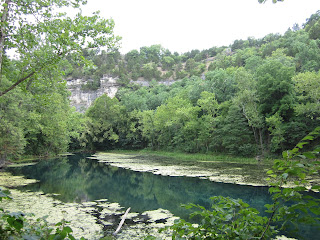Today’s adventure started early this morning. I got everyone up early so that we could beat the heat and go explore some trails and ruins at Ha Ha Tonka State Park, named for the Native American words for “land of the laughing water”. It was extra good that it was overcast today so when we left the hotel at 8 am it was 80 degrees. What a welcome relief!
What drew me to the Ha Ha Tonka State Park was the descriptions I read about on the state parks and in the vacation guide. Geologically, Ha Ha Tonka is classified as having “karst” topography, meaning the landscape is characterized by sinkholes, caves, underground streams, springs, and natural bridges. I had to see this in person, this geological wonderland, having only read about this kind of landscape and seeing examples in my geology textbooks.
 |
| View from 250 feet up of Lake of the Ozarks |
Caves and springs are formed primarily in the limestones and dolomites that make up most of this bedrock in these Ozarks. At the earth’s surface, rainwater combines with the carbon dioxide given off by decaying vegetation and forms a weak carbonic acid solution that moves down through joints, crevices, or fractures in the rock, dissolving it. The dissolved openings are the caves and spring conduits that make up the karst topography. We saw a huge (70 feet wide and 100 feet high) natural bridge/arch (depending on if you walk over the top or through the bottom) with a layer of 550 million-year-old dolomite covered in sandstone, and what is boasted to be Missouri’s 12th largest spring. We walked into the Colosseum sinkhole which is 500 by 300 feet, created when a huge cavern collapsed.
 |
| The natural bridge/arch |
Something else about Ha Ha Tonka that I thought would be interesting to see is the ruins of a burt-out stone shell of a “castle” built by a wealthy Kansas City businessman/grocer, Robert M. Snyder and his family, at the turn of the century. The mansion ruins sit on a 250-foot bluff and overlooks the Ha Ha Tonka Spring and the Lake of the Ozarks. Construction began in 1905 that included the mansion, carriage house, 80-foot water tower, and a greenhouse. Unfortunately a year later Snyder was killed in one of the state’s first automobile accidents. Snyder’s sons finished building it but in 1942 the entire interior was gutted by fire when sparks from a chimney ignited the mansion and carriage house’s roofs. Then in 1976 the water tower was burned by vandals. So all that remains today of the businessman’s dream are ruins.
 |
| The front side of the mansion |
 |
| The spring, a constant 56 degrees |
Of course, at Ha Ha Tonka, I also wanted to see the lush landscape that once concealed moonshiners and counterfeiters in the hills! We didn’t get to visit them, but there were two caves used as hideouts by criminals in the 1830s, Counterfeiter’s Cave and Robber’s Cave.
This afternoon's plan? Spiderman!









No comments:
Post a Comment